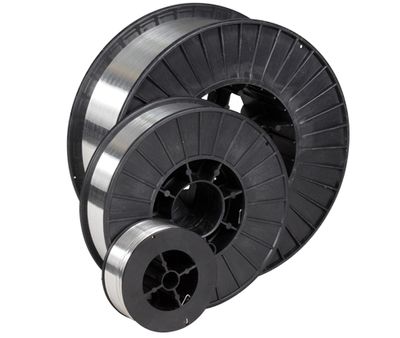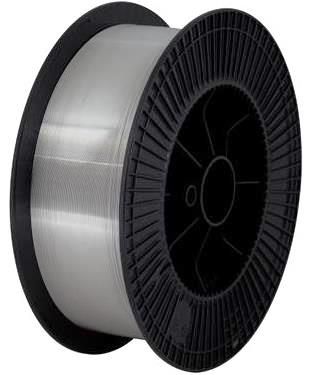Aluminium MIG Welding Wire

MIG (GMAW) Welding Wire for Aluminium, including 5356, 5183 & 4043 grades.
Browse the range below, or view the selection guide at bottom of this page.
You may also be interested in our guide on How to set up your MIG welder for aluminium welding.
-
5356 grade MIG (GMAW) wire for welding a wide range of magnesium-bearing aluminium alloys. One of the most widely-used grades of aluminium wire. A tried and proven quality wire, manufactured with strict quality-control, layer-wound for reliable wire feeding. Available in 0.9/1.0/1.2mm in 0.45/2/6kg spools.
-
5183 grade MIG wire for high-strength welding of 5083 and some other aluminium alloys. Offers excellent corrosion resistance and high strength (especially at lower temperatures), and is often used for applications such as boat & ship building, marine, cryogenics, etc. Sometimes referred to as 'marine grade'. Manufactured with strict quality-control, layer-wound for reliable wire feeding. Available in 1.2mm 6kg.
-
4043 grade MIG wire for welding a wide range of aluminium alloys. Especially suited for 6xxx series alloys. Offers excellent crack-resistance, fluid weld pool and is preferred by some welders because it “wets and flows better” and it also makes brighter looking welds. Manufactured with strict quality-control, layer-wound for reliable wire feeding. Available in 1.0mm & 1.2mm x 6kg.
Aluminium MIG Wire Selection Guide
|
Wire Type / Grade |
Sizes Available |
Suitable for welding these alloys types |
Common Applications / Comments |
|
0.9/1.0/1.2mm x 0.45/2/6kg spools |
5xxx magnesium-bearing alloys - including 5052, 5083, 5086, 5154, 5251, 5356, 5454, 5456. |
Most widely-used aluminium MIG wire grade due to compatability with many common base alloys & good strength. Typical tensile strength around 200-310 Mpa. Boats, bicycles, pressure vessels, automotive, repairs, maintenance, general aluminium fabrication. Not recommended for elevated service temperature applications (4043 may be a better choice for this application). |
|
|
1.2mm x 6kg |
5083, 5086 & 5456, to each other or to 5052, 5652 and 5056. |
Similiar to 5356, but offers higher strength on some base metals such as 5083. Typical tensile strength around 275-330 Mpa. Ideal for use where high corrosion resistance and toughness at lower temperatures is desired. Boats, shipbuilding, marine, cryogenic plants, pressure vessels. Not recommended for elevated service temperature applications (4043 may be a better choice for this application). |
|
|
1.0/1.2mm x 6kg |
Ideal for 6xxx heat-treatable alloys, including 6061 & 6063. Repair of alloy castings, mainly 4xxx and 6xxx series. Can be used for selected 1xxx & 5xxx alloys, although ER5356 or ER5183 may be a better choice for 5xxx. Joining of dissimiliar grades.
|
Excellent crack-resistance & fluid weld pool. Often chosen where balance of strength & ductility is required, such as materials subject to bending, flexing or forming. Typical tensile strength around 150-220 Mpa. Preferred by some welders because it “wets and flows better” and it also makes brighter looking welds. Resistant to hot cracking in many applications. Suitable for use in elevated temperature applications, where service temperature may exceed 65c. Automotive parts, vehicle body frames, structural, bicycles & scooters, repair and maintenance. |
What is Marine Grade Aluminium MIG Welding Wire?
Marine grade aluminum MIG welding wire is a type of welding wire specifically designed for welding aluminum alloys used in marine environments. These alloys are chosen for their superior resistance to corrosion, strength, and durability in harsh conditions, such as saltwater exposure. 5356 and 5183 alloy wires are commonly used for marine applications.
Conformance Batch Certificates for Aluminium MIG Welding Wire
Batch certificates, or conformance certificates, for Weldclass aluminium MIG wire are available online at https://www.weldclass.com.au/batchcert. Check batch label on the box and/or wire spool for the batch or lot number.
How To MIG Weld Aluminium
While MIG welding aluminium has challenges, it follows the same principles as welding steel and can be relatively easily mastered with the right equipment, knowledge, and a bit of practice. To get started, check out this comprehensive guide to set up your MIG welder for aluminium welding.




